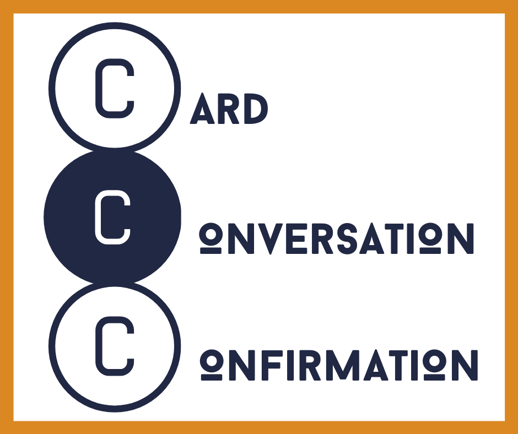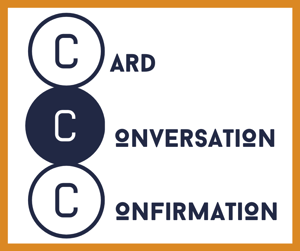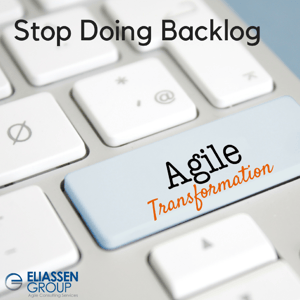Keys to Agile Transformation Success
The Executive job is to question results. The investment based on trust and goodwill only goes so far. Without proactive alignment on how to measure success, those responsible for “implementing Agile” have the daunting responsibility to prove that it's worth it to invest in Agile, often with waterfall-like status reports showing outputs and not outcomes. Questioning the return on investment, executives have no choice but to throttle back, demand a reset, or worst case - cancel the initiative all together. Ironically, the simplest solution to this problem may be to use a few good practices of Agile to implement Agile.
The first good Agile practice is “Card-Conversation-Confirmation” (CCC), to have a draft definition of value to be delivered in short order, followed by a conversation between sponsors and the Agile implementors, and then to confirm progress regularly with objective measurement. During this negotiation, the implementation team collaborates with the sponsors to define the maximum value, the viability of implementation, and how value will be measured and reported in some kind of quarterly Agile program review.

3 C's Concept by Ron Jeffries
The successful transformation pattern prioritizes the most valuable deliverables each quarter, including success measures for each. Adopting the mindset that each deliverable relies on many assumptions, the best practice is to write deliverables in hypothesis form and explicitly state what the expected value is, including how that value will be measured.
The manifestation of true Agile transformation is dependent on changing an organization to work in small cross functional teams that are responsible, accountable, and working together with a new mission and “flow” of value. A transformation requires significant change among its people in terms of roles, accountability, communication patterns, priorities, and day-to-day activities. Agreement and communication regarding definition of highest priority work items and how success will be measured enables 100% focus on delivering maximum value, which is another good Agile practice.
The first three keys to Agile transformation success are outlined below.
- Identify the Agile Program Sponsor(s): Engage to agree on long term vision, a roadmap and most importantly, 90-day valuable deliverables and measures of success. Set the expectation that there will be an Agile Program review every ~90 days in which success measures will be reviewed, the program is expected to learn and pivot, and the next 90-day valuable deliverables and success measures will be confirmed.
Common anti-patterns come from our legacy project and program management intuition. With long-time horizons, it feels efficient to do things in large batches and to leverage centralized decision making: train everybody, determine the ideal tool configuration, define a recipe for implementation, fund centralized workstreams, perhaps implement automated testing or a DevOps workstream. I will claim all these are traditional waterfall deliverables. None of them on their own result in small cross-functional teams delivering value. With the focus on valuable deliverables, everything else becomes subordinated. Applying more resources to highest value delivery delivers faster and highlights challenges of highest value delivery.
→ "Engage to agree on long term vision, a roadmap and most importantly, 90-day valuable deliverables and measures of success."
- The best measure of initial success is the number of maturing Agile teams. Early during a transformation, I claim that maximum value is the “quantity of maturing Agile teams,” and is best measured by some kind of Agile maturity assessment. What is most valuable and their respective measures will evolve over the course of a transformation, and depending on where the largest constraints exist, may next emphasize built-in-quality or predictability. Later success measures may include newly-implemented outcome metrics, or specific product line KPIs.
The Eliassen Agile Maturity Matrix is an industry-wide accepted tool used to establish baseline and monitor trends of Agile maturity. It is used primarily at the team level, and it also has organizational-level maturity dimensions. The value is derived from the conversations and topics supported by the 35+ areas of practices that are measured, and the side benefit is a maturity trend of how the team is progressing (or not). Teams hit plateaus as they mature; impediments become larger and eventually limit the teams’ control. Adept scrum masters facilitate problem solving sessions to determine best solutions to remove those impediments.
It’s never too late to begin baseline of maturity...
- Experienced Agile transformation coaches have a network of resources available to work around and handle a multitude of potential impediments: lack of training, understanding the “whys,” lack of clear audio on remote conference, or undue leadership intervention, to name a few. The best coaches not only have experience in finding many solutions to problems, they are also adept at empathizing, learning, and balancing the diversity of team members’ perspectives and to professionally coach the teams - to owning solutions through the teams’ discovery of solutions.
The real value of coaching is change management: working with the organization to empathize, to answer questions, to help them develop courage, to experiment with new ways, to eventually adopt better practices, and to eventually build an Agile mindset.
→ "The real value of coaching is change management."
When it comes to measuring value, there's so much more to explore. Read Part 2 of our series on Agile Transformation. And remember that Eliassen can help you source experienced coaches for your transformation, and our rigorous screening process makes sure the coaches we present are experienced in the role you specify and will match the culture of your organization.
Eliassen = Experience


